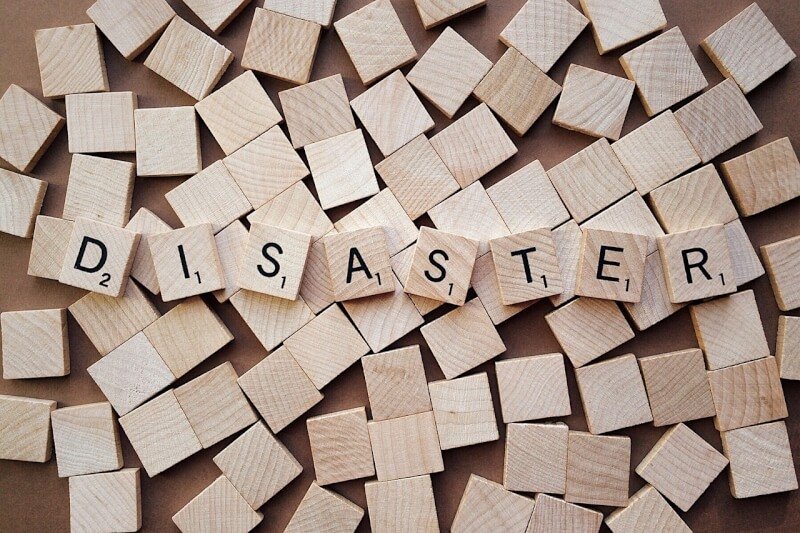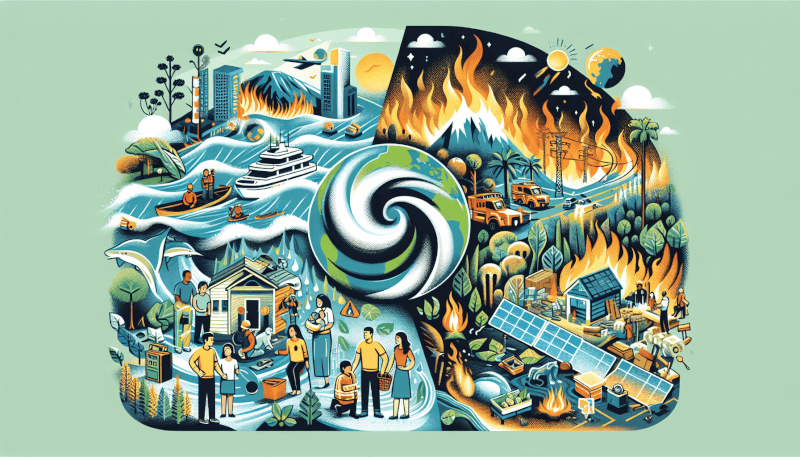Imagine living in a world where unpredictable forces of nature can strike at any moment, shattering the peace and stability of your daily life. From earthquakes that shake the ground beneath your feet to powerful hurricanes that unleash their fury upon entire cities, natural disasters can leave a lasting impact on communities and individuals alike. In this article, we will explore the diverse range of natural disasters that can occur, their devastating consequences, and the measures we can take to prepare and protect ourselves from their wrath. Brace yourself for a journey into the realm of natural disasters, where awe-inspiring forces of nature remind us of our vulnerability, but also our resilience in the face of adversity.

Causes of Natural Disasters
Tectonic activity
Tectonic activity, which involves the movement of Earth’s tectonic plates, is one of the major causes of natural disasters. When these plates collide, separate, or slide past each other, it can result in earthquakes, one of the most destructive natural disasters. Earthquakes occur when the accumulated stress between two plates is released suddenly, causing the ground to shake violently. These seismic events can lead to widespread devastation, causing buildings to collapse, infrastructure to crumble, and loss of life.
Extreme weather events
Extreme weather events, such as hurricanes, cyclones, tornadoes, and droughts, are also significant causes of natural disasters. These events are primarily driven by atmospheric conditions and can result in severe damage and loss of life. Hurricanes and cyclones, for example, form over warm ocean waters and can bring about destructive winds, storm surges, and heavy rainfall. Tornadoes, on the other hand, occur during severe thunderstorms and can cause significant destruction within a short period. Droughts, characterized by prolonged periods of scarce rainfall, can lead to water shortages, crop failure, and negative impacts on ecosystems.
Volcanic eruptions
Volcanic eruptions, although less frequent than other natural disasters, can be incredibly devastating. When volcanoes erupt, they expel hot ash, lava, and gases into the air, posing risks to nearby communities. These eruptions can lead to the destruction of infrastructure, displacement of populations, and adverse effects on air quality. Volcanic ash can also disrupt transportation systems and agricultural activities, causing economic losses.
Landslides and avalanches
Landslides and avalanches often occur in mountainous regions and are triggered by factors such as heavy rainfall, earthquakes, or human activities. Landslides involve the downward movement of rocks, soil, and debris, while avalanches refer to the sudden release of snow down a slope. These natural disasters can bury homes, block roads, and pose significant threats to human lives. Regions prone to landslides and avalanches need to implement measures to mitigate the risks and protect communities.
Floods and tsunamis
Floods and tsunamis are natural disasters associated with excessive water levels. Floods can occur due to heavy rainfall, dam failures, or the overflow of rivers and other bodies of water. The consequences of floods can be devastating, leading to loss of life, damage to infrastructure, and contamination of water sources. Tsunamis, which are triggered by underwater seismic activity, can also cause widespread destruction once they reach the shores. Coastal areas near earthquake-prone zones must have early warning systems and evacuation plans to minimize the impacts of tsunamis.
Types of Natural Disasters
Earthquakes
Earthquakes, as mentioned earlier, result from the sudden release of accumulated stress between tectonic plates. The severity of an earthquake is measured using the Richter scale, with higher magnitudes indicating more significant impacts. In addition to the shaking of the ground, earthquakes can also trigger landslides, tsunamis, and liquefaction, a phenomenon where saturated soil temporarily loses strength and behaves like a liquid.
Hurricanes and cyclones
Hurricanes and cyclones are massive, rotating storm systems characterized by low-pressure centers and strong winds. These tropical cyclones form over warm ocean waters and can unleash destructive winds and heavy rainfall upon landfall. The Saffir-Simpson Hurricane Wind Scale is used to categorize hurricanes based on their intensity, with Category 5 hurricanes being the most severe.
Tornadoes
Tornadoes are violent, rapidly rotating columns of air that form under specific atmospheric conditions. These destructive vortices are commonly associated with severe thunderstorms and can cause significant damage within their narrow paths. The Enhanced Fujita Scale rates tornadoes based on the damage they cause, ranging from EF0 (minor damage) to EF5 (incredible damage).
Droughts
Droughts are prolonged periods of unusually low rainfall, resulting in water scarcity and a lack of moisture in the soil. These events can have severe consequences for agriculture, ecosystems, and water supply. Droughts can also lead to increased wildfire risks, economic losses, and food insecurity, particularly in regions heavily dependent on agriculture.
Wildfires
Wildfires, or forest fires, are uncontrolled fires that rapidly spread across vegetation and can destroy vast areas of land. These fires often occur in dry and hot climates, fueled by dry vegetation, strong winds, and human activities. Wildfires can have devastating impacts, destroying forests, wildlife habitats, and even human settlements. They can also lead to air pollution, affecting air quality and human health.
Floods
Floods occur when there is an overflow of water onto normally dry land. Heavy rainfall, dam failures, or the rapid melting of snow can all contribute to flooding. Flash floods, characterized by sudden and rapid rises in water levels, are particularly dangerous. Floods can cause extensive damage to infrastructure, contaminate water sources, and lead to the loss of life.
Landslides
Landslides, as discussed earlier, involve the downward movement of rocks, soil, and debris. These mass movements can occur due to heavy rainfall, earthquakes, or human activities that destabilize slopes. Landslides can bury structures, block roads, and pose risks to human lives. Rapid response and early warning systems are crucial in mitigating the impacts of landslides.
Volcanic eruptions
Volcanic eruptions, characterized by the release of molten lava, ash, and gases, can cause widespread destruction. The severity of volcanic eruptions varies, with some remaining relatively contained within the volcano, while others result in the evacuation of communities and significant damage to infrastructure. Active supervision of volcanic activity and effective communication with at-risk populations are essential to minimize the impacts of eruptions.
Tsunamis
Tsunamis are massive ocean waves triggered by underwater seismic activity, such as earthquakes or volcanic eruptions. These waves can travel across vast distances and, upon making landfall, can cause extensive destruction. Early warning systems and evacuation plans are crucial in saving lives and reducing the impacts of tsunamis.
Impacts of Natural Disasters
Loss of human life
One of the most tragic consequences of natural disasters is the loss of human life. Earthquakes, hurricanes, floods, and other disasters can lead to fatalities, leaving families and communities devastated. In densely populated areas or regions with inadequate infrastructure or emergency response systems, the loss of life can be particularly high.
Injuries and health issues
In addition to loss of life, natural disasters can also result in severe injuries and health issues. Collapsed buildings, debris, and contaminated water sources can cause injuries, infections, and the spread of diseases. Victims may require immediate medical attention and access to clean water and sanitation facilities to prevent further health complications.
Property damage and destruction
Natural disasters often cause significant damage and destruction to buildings, infrastructure, and personal property. Earthquakes can collapse structures, hurricanes can rip roofs off houses, and floods can submerge entire communities. The cost of rebuilding and repairing damaged properties can be overwhelming, particularly for individuals and communities with limited resources.
Displacement and homelessness
When natural disasters strike, many people are forced to leave their homes due to the destruction and unsafe conditions. Displacement and homelessness become prominent issues, leading to overcrowded shelters or makeshift camps. The loss of personal belongings, familiar surroundings, and stable living conditions can have long-lasting psychological impacts on those affected.
Environmental damage
Natural disasters can have severe environmental consequences. Forests can be decimated by wildfires, coastlines can be eroded by tsunamis, and ecosystems can be disrupted by floods. The loss of biodiversity and destruction of natural habitats can have long-term effects on ecosystems, disrupting the delicate balance of nature and threatening the survival of species.
Prevention and Preparedness
Early warning systems
Early warning systems are crucial in minimizing the impacts of natural disasters. By monitoring seismic activity, weather patterns, and other relevant indicators, authorities can issue timely warnings to at-risk populations. These warnings can provide individuals and communities with valuable time to evacuate, seek safety, or prepare for the impending disaster.
Infrastructure planning
Proper infrastructure planning plays a vital role in minimizing the damage caused by natural disasters. Stronger buildings, bridges, and roads can withstand the forces of earthquakes, hurricanes, and floods. Effective drainage systems can help prevent flooding, and robust communication networks are essential for disseminating information during emergencies.
Community education and preparedness
Educating communities about natural disasters and proper emergency response is crucial for their safety and resilience. Training individuals on evacuation procedures, first aid, and situational awareness can empower them to take appropriate actions during a crisis. Additionally, promoting disaster preparedness through educational campaigns and workshops can help reduce vulnerabilities and save lives.
Emergency response measures
Efficient emergency response measures are critical for saving lives and providing immediate assistance during and after natural disasters. Well-trained and equipped emergency personnel should be able to respond swiftly to affected areas, providing medical care, search and rescue operations, and essential supplies. Effective coordination between local, regional, and national authorities is essential for a successful response.

Mitigation and Resilience
Building codes and regulations
Implementing and enforcing strong building codes and regulations is essential in minimizing the damage caused by natural disasters. Structures designed to withstand earthquakes, hurricanes, and other hazards can significantly reduce the risks to human life and property. Regular inspections and adherence to building standards ensure the resilience of communities and infrastructure.
Land-use planning
Strategic land-use planning can help mitigate the impacts of natural disasters by avoiding high-risk areas or implementing appropriate safeguards. Identifying floodplains, landslide-prone zones, and areas susceptible to coastal erosion allows authorities to develop policies that limit human exposure to these hazards.
Insurance and financial mechanisms
Insurance and financial mechanisms play a crucial role in supporting individuals and communities affected by natural disasters. Adequate insurance coverage can help homeowners and businesses recover financially after property damage. Furthermore, government-funded disaster relief programs and international assistance can provide resources for rebuilding efforts and meeting immediate needs.
Climate change adaptation
In light of the increasing frequency and intensity of natural disasters, adapting to climate change is paramount. Mitigating greenhouse gas emissions and taking measures to limit global warming can help reduce the severity of extreme weather events. Investing in climate resilient infrastructure, diversifying energy sources, and promoting sustainable practices are critical in building resilience to future disasters.
International Cooperation and Assistance
United Nations framework
The United Nations (UN) plays a vital role in fostering international cooperation and assistance in disaster management. Through various specialized agencies, such as the United Nations Office for Disaster Risk Reduction (UNDRR) and the United Nations International Strategy for Disaster Reduction (UNISDR), the UN facilitates knowledge sharing, capacity building, and coordination among countries.
Humanitarian aid and support
Humanitarian aid and support from international organizations, governments, and non-governmental organizations (NGOs) are crucial during and after natural disasters. Immediate relief in the form of food, water, medical supplies, and shelter can help meet the basic needs of affected populations. Long-term support, such as infrastructure development and rehabilitation programs, focuses on rebuilding communities and improving resilience.
Global partnerships
Global partnerships are essential in addressing the complex challenges posed by natural disasters. Collaborations between governments, NGOs, academia, and the private sector can contribute to knowledge exchange, innovative solutions, and resource mobilization. Developing standardized practices, sharing best practices, and supporting research efforts can enhance disaster preparedness and response worldwide.

Case Study: Great East Japan Earthquake
Background and magnitude
On March 11, 2011, Japan experienced one of the most powerful earthquakes in its history, known as the Great East Japan Earthquake. The magnitude 9.0 earthquake occurred off the northeastern coast of Japan, triggering a massive tsunami that devastated coastal communities. The tsunami waves reached heights of over 40 meters and traveled several kilometers inland, causing widespread destruction.
Impacts and aftermath
The Great East Japan Earthquake resulted in immense human suffering and property damage. It claimed the lives of over 15,000 people, injured thousands more, and left countless others displaced. Whole towns were wiped off the map, and infrastructure, including roads, buildings, and power plants, was severely damaged. The disaster also led to the Fukushima nuclear accident, causing further environmental concerns and health risks.
Reconstruction efforts
Following the disaster, Japan launched an extensive and ambitious reconstruction plan to rebuild affected areas and support affected communities. The government prioritized restoring infrastructure, providing financial assistance to affected residents and businesses, and ensuring the safe return of evacuated populations. Furthermore, the disaster prompted a reevaluation of Japan’s disaster response systems and policies, leading to updates in early warning systems, emergency preparedness measures, and building codes to enhance resilience.
Conclusion
Natural disasters can have devastating impacts on human life, infrastructure, and the environment. Understanding the causes, types, and impacts of these disasters is crucial for implementing effective prevention, preparedness, mitigation, and resilience measures. Through international cooperation, assistance, and case studies like the Great East Japan Earthquake, we can learn valuable lessons and work towards building safer and more resilient communities. By prioritizing the safety and well-being of individuals and implementing proactive measures, we can minimize the loss of life and property caused by natural disasters.



